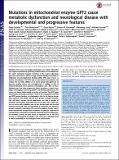| dc.contributor.author | Ouyang, Qing | |
| dc.contributor.author | Nakayama, Tojo | |
| dc.contributor.author | Baytas, Ozan | |
| dc.contributor.author | Yang, Chendong | |
| dc.contributor.author | Schmidt, Michael | |
| dc.contributor.author | Lizarraga, Sofia B. | |
| dc.contributor.author | Mishra, Sasmita | |
| dc.contributor.author | EI-Quessny, Malak | |
| dc.contributor.author | Niaz, Saima | |
| dc.contributor.author | Gul Butt, Mirrat | |
| dc.contributor.author | Imran Murtaza, Syed | |
| dc.contributor.author | Javed, Afzal | |
| dc.contributor.author | Chaudhry, Haroon Rashid | |
| dc.contributor.author | Vaughan, Dylan J. | |
| dc.contributor.author | Hill, R. Sean | |
| dc.contributor.author | Partlow, Jennifer N. | |
| dc.contributor.author | Yoo, Seung-Yun | |
| dc.contributor.author | Lam, Anh-Thu N. | |
| dc.contributor.author | Nasir, Ramzi | |
| dc.contributor.author | Al-Saffar, Muna | |
| dc.contributor.author | Barkovich, A. James | |
| dc.contributor.author | Schwede, Matthew | |
| dc.contributor.author | Nagpal, Shailender | |
| dc.contributor.author | Rajab, Anna | |
| dc.contributor.author | DeBerardinis, Ralph J. | |
| dc.contributor.author | Mochida, Ganeshwaran H. | |
| dc.contributor.author | Morrow, Eric M. | |
| dc.contributor.author | Davidson, Shawn M | |
| dc.contributor.author | Housman, David E | |
| dc.date.accessioned | 2017-05-10T19:53:18Z | |
| dc.date.available | 2017-05-10T19:53:18Z | |
| dc.date.issued | 2016-09 | |
| dc.date.submitted | 2016-02 | |
| dc.identifier.issn | 0027-8424 | |
| dc.identifier.issn | 1091-6490 | |
| dc.identifier.uri | http://hdl.handle.net/1721.1/108797 | |
| dc.description.abstract | Mutations that cause neurological phenotypes are highly informative with regard to mechanisms governing human brain function and disease. We report autosomal recessive mutations in the enzyme glutamate pyruvate transaminase 2 (GPT2) in large kindreds initially ascertained for intellectual and developmental disability (IDD). GPT2 [also known as alanine transaminase 2 (ALT2)] is one of two related transaminases that catalyze the reversible addition of an amino group from glutamate to pyruvate, yielding alanine and α-ketoglutarate. In addition to IDD, all affected individuals show postnatal microcephaly and ∼80% of those followed over time show progressive motor symptoms, a spastic paraplegia. Homozygous nonsense p.Arg404* and missense p.Pro272Leu mutations are shown biochemically to be loss of function. The GPT2 gene demonstrates increasing expression in brain in the early postnatal period, and GPT2 protein localizes to mitochondria. Akin to the human phenotype, Gpt2-null mice exhibit reduced brain growth. Through metabolomics and direct isotope tracing experiments, we find a number of metabolic abnormalities associated with loss of Gpt2. These include defects in amino acid metabolism such as low alanine levels and elevated essential amino acids. Also, we find defects in anaplerosis, the metabolic process involved in replenishing TCA cycle intermediates. Finally, mutant brains demonstrate misregulated metabolites in pathways implicated in neuroprotective mechanisms previously associated with neurodegenerative disorders. Overall, our data reveal an important role for the GPT2 enzyme in mitochondrial metabolism with relevance to developmental as well as potentially to neurodegenerative mechanisms. | en_US |
| dc.description.sponsorship | National Institute of Neurological Diseases and Stroke (U.S.) (R01NS035129) | en_US |
| dc.description.sponsorship | United States. National Institutes of Health (R21TW008223) | en_US |
| dc.description.sponsorship | National Cancer Institute (U.S.) (R01CA157996) | en_US |
| dc.language.iso | en_US | |
| dc.publisher | National Academy of Sciences (U.S.) | en_US |
| dc.relation.isversionof | http://dx.doi.org/10.1073/pnas.1609221113 | en_US |
| dc.rights | Article is made available in accordance with the publisher's policy and may be subject to US copyright law. Please refer to the publisher's site for terms of use. | en_US |
| dc.source | PNAS | en_US |
| dc.title | Mutations in mitochondrial enzyme GPT2 cause metabolic dysfunction and neurological disease with developmental and progressive features | en_US |
| dc.type | Article | en_US |
| dc.identifier.citation | Ouyang, Qing; Nakayama, Tojo; Baytas, Ozan; Davidson, Shawn M.; Yang, Chendong; Schmidt, Michael; Lizarraga, Sofia B. et al. “Mutations in Mitochondrial Enzyme GPT2 Cause Metabolic Dysfunction and Neurological Disease with Developmental and Progressive Features.” Proceedings of the National Academy of Sciences 113, no. 38 (September 2016): E5598–E5607. © 2016 National Academy of Sciences | en_US |
| dc.contributor.department | Massachusetts Institute of Technology. Department of Biology | en_US |
| dc.contributor.mitauthor | Davidson, Shawn M | |
| dc.contributor.mitauthor | Housman, David E | |
| dc.relation.journal | Proceedings of the National Academy of Sciences | en_US |
| dc.eprint.version | Final published version | en_US |
| dc.type.uri | http://purl.org/eprint/type/JournalArticle | en_US |
| eprint.status | http://purl.org/eprint/status/PeerReviewed | en_US |
| dspace.orderedauthors | Ouyang, Qing; Nakayama, Tojo; Baytas, Ozan; Davidson, Shawn M.; Yang, Chendong; Schmidt, Michael; Lizarraga, Sofia B.; Mishra, Sasmita; EI-Quessny, Malak; Niaz, Saima; Gul Butt, Mirrat; Imran Murtaza, Syed; Javed, Afzal; Chaudhry, Haroon Rashid; Vaughan, Dylan J.; Hill, R. Sean; Partlow, Jennifer N.; Yoo, Seung-Yun; Lam, Anh-Thu N.; Nasir, Ramzi; Al-Saffar, Muna; Barkovich, A. James; Schwede, Matthew; Nagpal, Shailender; Rajab, Anna; DeBerardinis, Ralph J.; Housman, David E.; Mochida, Ganeshwaran H.; Morrow, Eric M. | en_US |
| dspace.embargo.terms | N | en_US |
| dc.identifier.orcid | https://orcid.org/0000-0001-5016-0756 | |
| mit.license | PUBLISHER_POLICY | en_US |
